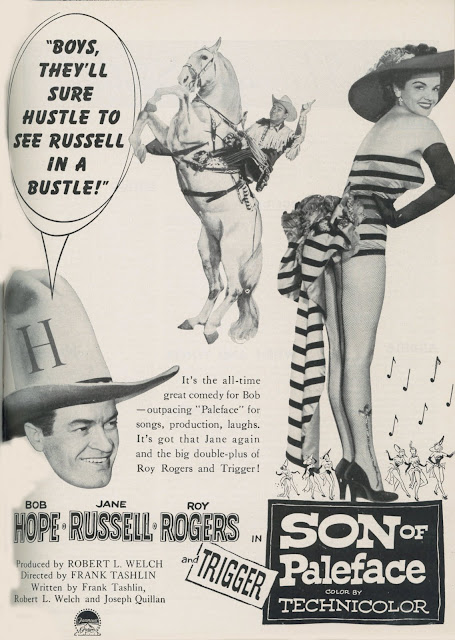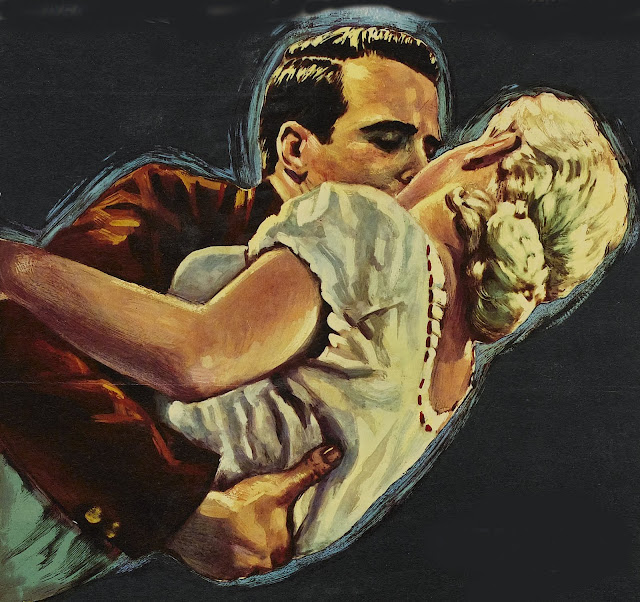
Selling Son Of Paleface --- Part Two
To that data of Philadelphia bidding $27,500 in advance for Son Of Paleface should be added this: They had to guarantee $37,500 for Martin and Lewis in Jumping Jacks and six weeks minimum playing time as opposed to Paleface's four. So what did this say to Bob Hope's primacy on the Paramount lot? The Dean and Jerry snowball had rolled for going on three years, its peak in sight for 1952's summer and giddy anticipation for Jumping Jacks. These boys were the fad Abbott and Costello had been ten years before, only to crowds bigger. Bob was around before either and his just showing up was no longer assured boxoffice. Jacks was beating M&L's previous Sailor Beware by a third in many houses, startling all the more was its largest take for Paramount since DeMille's Samson and Delilah and ongoing smash The Greatest Show On Earth. Numbers would tell the tale ... Jumping Jacks finished with $4.1 million in domestic rentals to Son Of Paleface's $3.1. Unkindest cut for Paramount lay in both having been independently financed and shot, by producer Hal Wallis and Hope Enterprises respectively. With Para little more than distributor, thickest gravy would be Wallis and Hope's to scoop.

So could there be wonder at Bob's willingness to pump for Paleface oil? He had radio and emerging TV to help with that. Exposure to either got you wired to his newest in theatres. Hope dropped in on the New York Paramount's opening night to join Louis Prima on stage and introduce SOP, that stand good for a first week swelled to $75G's. Jane Russell was meanwhile Chicago ways to help a newly reopened Oriental Theatre christen Son Of Paleface. There was too Roy Rogers' rodeo situated at Madison Square Gardens, spreading Paleface word through capacity bleachers. Such was media exposure of these combined that got message to masses undreamt of in today's scattered marketplace. Where I lived (well, not yet ... two years to wait for that), exhib friend-to-be Garland Morrison was ass't manager at nearby Elkin, NC's Reeves Theatre, assigned to bally Son Of Paleface without benefit of Bob, Jane, or Roy personal appearing. Garland came through with a borrowed buckboard he'd park front of the entrance with stills and playdate attached. That stunt got him ink in Boxoffice, but I can't help wondering ... weren't functioning buckboards still a fairly common sight on 1952 Elkin streets? They were in neighboring small towns, including my own.

Roy Rogers hadn't intended for Son Of Paleface to be a last theatrical feature. There'd been a break with Republic, recriminations following, and all-over TV dump of westerns sans Rogers' consent he felt entitled to. The company also spread thin reissued oldies to trade on RR's continuing popularity. This King Of Cowboys had built a cross-biz empire nearly a size of Autry's, both entering vid spheres with respective half-hour series in play as Son Of Paleface opened. Roy wanted back in features on independent terms --- was observing Bob Hope's operation a hint? There would be new RR westerns in color and widescreen, released through United or perhaps Allied Artists. That was at least Rogers' plan by 1954, but it wouldn't come off for reasons perhaps lost to time. A return to big screens post-Son Of Paleface might just have been the ticket, for in its way, SOP is among slickest and most accomplished of outdoor shows Roy did. Drop Hope and the thing plays like any of a dozen westerns Rogers did, only this time a much wider audience was getting what for many was first-time exposure to the sagebrush star.


Son Of Paleface's negative became asset of Hope Enterprises. So had a number of his other past Paramount releases. There'd be bookings, occasionally as bottom of duals, into the sixties, but no dedicated reissue. Hope had too much fresh product to compete with himself via vaulties. Besides, he'd revisit Son Of Paleface as Alias Jesse James in 1959, same old west setting and airing of gags that clicked before. What Bob (and partnering NBC) did have of considerable value was backlog of negs coveting syndicators wanted for 60's television lease. Trades heralded Allied Artists-TV scoring the lot in June 1963, ten years of use upon payment of $850,000 for seven Hope starring features dating from 1947's Road To Rio, and all had been solid hits in theatres (one of the highest prices paid for pix for TV, said Variety). A pair had tube-run earlier, Rio and My Favorite Brunette, but The Lemon Drop Kid, The Seven Little Foys, The Road To Bali, The Great Lover, and Son Of Paleface would be new to airwaves and likely major lures. AA even announced reissue for the group under a "Hope Jubilee" umbrella, but I found no evidence of that coming off. Indeed, the package was made available to broadcasters within weeks of the deal, July being launch for the seven to local channels. Son Of Paleface has been released on DVD several times, not always from flattering elements. I'd like knowing who stores negatives of the group with Bob gone. Does his family maintain an interest, or more to point, are they interested? There was packaging of four in the old HD-DVD format, certainly a best I've seen these pictures look. Welcome would be all Hope Enterprise titles arriving in a Blu-Ray box, but with DVD sales in general decline, I guess that isn't likely to happen.

















































